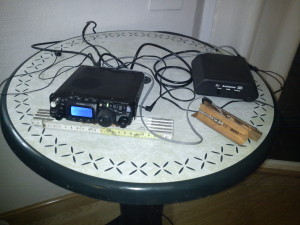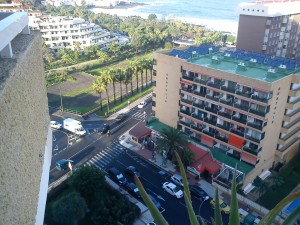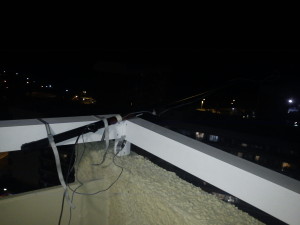WSPR ( Weak Signal Propagation Reporter ) is a mode created by K1JT ( Nobel Laureate in Physics ) . The measurement results can be sent over the Internet to a common server that presents the results in an Excel friendly format . The stations transmit and listen by turns and all results are uploaded . It may look like this . Signal / Noise level specified relates to a bandwidth of 2.5 kHz .
A travel to EA8 2014
In November 2014 XYL and I made a trip to Tenerife. I looked for a hotel with a good radio location and a room with “sea view”. The choice fell on hotel “Luabay” in Puerto de la Cruz. There was a free take off across the Atlantic Ocean from the Southwest to the Northeast.
The equipment was a FT 817nd with a small PS, an ATU, a manipulator of soldered copper laminate pieces and earpieces. The antenna was a wire along a 5 meter long telescopic fishing rod, an equally long counterpoise wire and a short wire with a powerful battery clamp for earthing to the balcony railing. The antenna was fed with 5 meters of RG-58 which was wound on a ferrite core at the antenna. The antenna pointed due west. The tuner managed to adjust the antenna system from 30 m to 15 m.
Most contacts were made with HAMs on the East Coast of the United States. Some were rag chew QSOs with QRP stations, having between 1 and 10 watts. But also numerous contacts with Europe, South America and the Caribbean. All contacts were made on CW.
I only had the antenna on the balcony when it was dark:
Below are some Reverse Beacon spots.
Good signals on 20m late at night at the end of November with 5W and a piece of wire.
At home in Stockholm the band closed when the sun sets early in the afternoon.
| PJ2T | EA8/SM0BRF | 14022.5 | CW CQ | 8 dB | 17 wpm | 2112z 28 Nov |
| K3MM | EA8/SM0BRF | 14022.7 | CW CQ | 13 dB | 17 wpm | 2112z 28 Nov |
| WZ7I | EA8/SM0BRF | 14022.6 | CW CQ | 15 dB | 17 wpm | 2111z 28 Nov |
| K3LR | EA8/SM0BRF | 14022.7 | CW CQ | 26 dB | 17 wpm | 2110z 28 Nov |
| KM3T | EA8/SM0BRF | 14022.5 | CW CQ | 24 dB | 17 wpm | 2110z 28 Nov |
| K2NNY | EA8/SM0BRF | 14022.5 | CW CQ | 17 dB | 17 wpm | 2110z 28 Nov |
| W4KKN | EA8/SM0BRF | 14022.6 | CW CQ | 17 dB | 17 wpm | 2110z 28 Nov |
| K8AZ | EA8/SM0BRF | 14022.7 | CW CQ | 13 dB | 17 wpm | 2110z 28 Nov |
| DF4UE | EA8/SM0BRF | 14022.6 | CW CQ | 11 dB | 17 wpm | 2109z 28 Nov |
| DK0TE | EA8/SM0BRF | 14022.6 | CW CQ | 6 dB | 17 wpm | 2109z 28 Nov |
| PY1NB | EA8/SM0BRF | 14058.1 | CW CQ | 11 dB | 17 wpm | 2057z 28 Nov |
| WZ7I | EA8/SM0BRF | 14058.1 | CW CQ | 16 dB | 17 wpm | 2057z 28 Nov |
| K3LR | EA8/SM0BRF | 14058.2 | CW CQ | 19 dB | 17 wpm | 2057z 28 Nov |
| K8AZ | EA8/SM0BRF | 14058.3 | CW CQ | 14 dB | 17 wpm | 2057z 28 Nov |
| K1TTT | EA8/SM0BRF | 14058.2 | CW CQ | 14 dB | 17 wpm | 2057z 28 Nov |
| KM3T | EA8/SM0BRF | 14058.0 | CW CQ | 21 dB | 17 wpm | 2056z 28 Nov |
| NZ1U | EA8/SM0BRF | 14058.2 | CW CQ | 15 dB | 17 wpm | 2056z 28 Nov |
Antennas for 80m
For 80 meters there are two inverted vee dipoles with apexes 20 meters above ground. One is provided with a parasitic element, which can be configured either as a director or reflector. The directions are SW or NE.
The other one has one leg almost horizontal towards SW and the other leg is going down almost vertically with the end about 7 meters to the NW. One could call it an inverted L dipole.
Antennas for160 m
For 160 m the whole tower plus the top mast, around 28 m, is used with the Yagi antennas as a capacitive top load. The tower is supplied with Gamma Match and connected to a sparse radial system. Self-resonance is 2.2 MHz.
There is also a low dipole configured as an inv vee with top at 20m.



